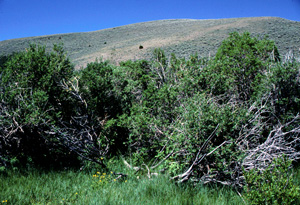Community Field Guide
Scientific Name:
Salix geyeriana / Carex utriculata Shrubland
Common Name:
Geyer willow / beaked sedge Shrubland
Community Description
Summary:
In Colorado, this riparian shrubland occurs often on wet soils, that are saturated throughout much of the growing season. Stands have a 1.5- to 2.5-m tall, nearly closed canopy that is dominated by the deciduous shrub Salix geyeriana with a thick carpet of graminoids in the undergrowth that is dominated by Carex utriculata. Information on stands that occur outside Colorado will be added later.
Environment:
The Salix geyeriana / Carex utriculata association can be found in montane habitats in western Montana (from valley bottoms to mid-elevations in the mountains) and in the mountains of central and eastern Montana. It is frequently found on alluvial terraces where beaver activity has created a series of dams that raise the local water table, along streams, and near seeps or springs. Soils are usually fine textured mineral soils that accumulate during periodic flooding events, and they may have a surface organic horizon. Soil reaction is neutral to moderately alkaline (pH 7.0 to 7.5), and this community is usually flooded during spring and early summer, with the water level near the surface the rest of the year. Nearby wetter communities could include Carex utriculata, Typha latifolia, or open water, and nearby drier communities could include Salix geyeriana / Calamagrostis canadensis, Calamagrostis canadensis, Deschampsia caespitosa (=Deschampsia cespitosa), or Juncus balticus. A variety of adjacent uplands could occur nearby, ranging from conifer dominated communities to dry shrublands such as Artemisia tridentata associations (Hansen et al. 1988, Hansen et al. 1995).
Vegetation:
The Salix geyeriana / Carex utriculata association typically has a somewhat open aspect with an overstory dominated by Salix geyeriana (32% average cover) which occurs as large clumps. The diversity of shrub species occurring in this type is notable, particularly among the Salix spp. (14 species) of which Salix wolfii, Salix planifolia, Salix drummondiana, and Salix boothii have at least 20% constancy and 10% average cover. Carex utriculata is by far the undergrowth dominant, followed in importance by Carex aquatilis and distantly by Calamagrostis canadensis, Juncus balticus and Deschampsia cespitosa. Commonly associated forb species are Aster occidentalis, Epilobium ciliatum, Geum macrophyllum, Mentha arvensis and Equisetum arvense. This community can occur as a part of a diverse mosaic of wetland types depending on degree and frequency of flooding, scouring, channel changes, and beaver activity (Hansen et al. 1995).
Range:
This community is found in Montana, Idaho, eastern Oregon, Utah, Nevada, Colorado, and Wyoming.
Management: Carex utriculata palatability is variable, but it may be heavily utilized on narrow riparian sites within extensive rangelands. Continued overgrazing can dry the site and lead to increases in exotic grass cover. The wet and often saturated soils of this association are vulnerable to compaction by livestock (Hansen et al. 1995). Burning of this association temporarily increases productivity of the sedge understory and can effectively rejuvenate decadent clumps of willows. Geyer’s willow will sprout quickly after quick, hot fires. However, burned sites shouldn’t be grazed for 2-3 years to avoid attracting livestock to young, palatable re-growth (Hansen et al. 1995).
Salix geyeriana / Carex utriculata stands exposed to heavy browsing pressure usually show reduced vigor of the willow species, such as highlining, clubbing, or dead clumps, with eventual decrease in willow coverage. Livestock disturbance in drier Salix geyeriana / Carex utriculata stands can result in increases in cover of exotic pasture grasses (e.g. Poa pratensis, Agrostis stolonifera, Bromus inermis), however, these exotics pose less threat here than in the drier Salix geyeriana / Calamagrostis canadensis association. Weedy forbs include Taraxacum officinale, Cirsium arvense, and Chrysanthemum leucanthemum, though their populations seldom threaten the site.
Global Rank: G5 State Rank: S5
Community References
Identifier:
CEGL001207
Author:
1999-10-15 / J. Greenlee, MTNHP
View Detailed Citation Information | New Community Search | NatureServe Explorer Community Information
This information is from the:
Montana Natural Heritage Program
Montana State Library--Natural Resource Information System
1515 East Sixth Ave., Helena, MT 59620-1800
406 444-3989
mtnhp.org
mtnhp@mt.gov






